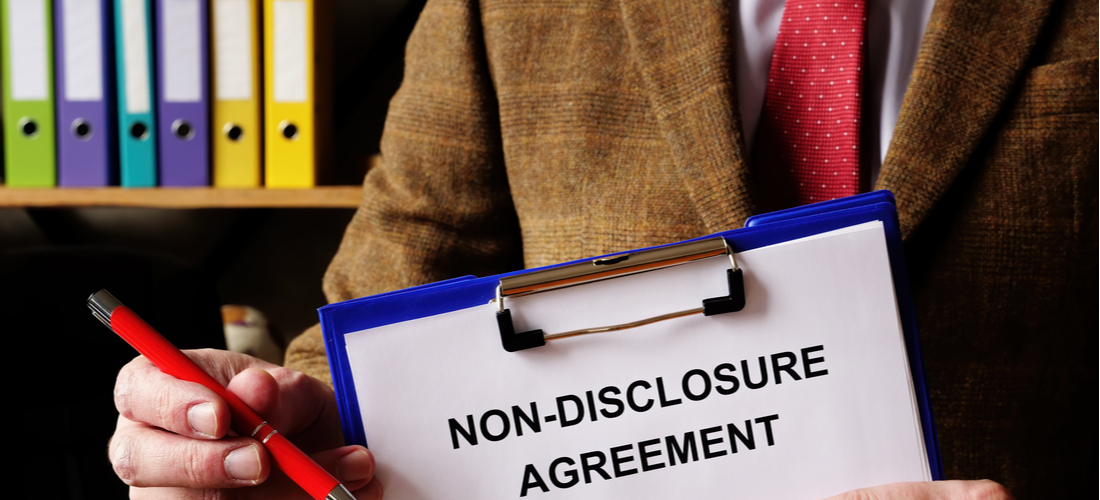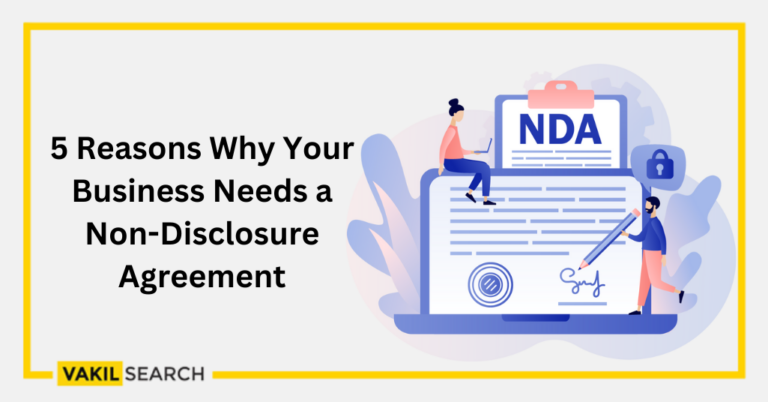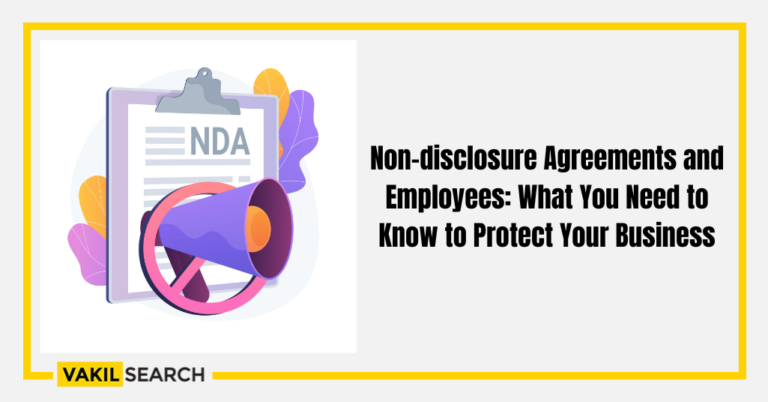This blog covers and guides all the Important aspects of the Non-disclosure Agreement and the steps to execute it to maintain confidentiality.
Many scenarios exist in which you exchange data and information with others but do not want this information to be shared with other parties or competitors. A non-disclosure agreement, known as an ‘NDA,’ may be able to assist.
In this blog, we’ll explore what a non-disclosure contract is, how to create one, when to use a non-disclosure agreement, and when not to.
What is the Non-disclosure Contract?
A non-disclosure pact is enforceable by law that creates a confidentiality connection between two parties. The signing parties acknowledge that any confidential material they collect will not be shared with anyone else. A confidentiality clause is another name for an Agreement.
Non-disclosure contracts are frequently used by companies when negotiating with other firms. They help both parties to transmit confidential material without the risk of it falling into the wrong hands. It’s termed a joint non-disclosure contract.
A non-disclosure contract can be utilised in different scenarios. Consider these factors, among other things:
- An Employment engagement in which the employee receives from the employer competitively top-secret information.
- Conversations with a potential acquisition contender who will have accessibility to the company’s financial statements.
- Delivering information to stakeholders about things that are not (yet) covered by copyright laws.
Non-disclosure contracts are useful in a variety of circumstances. When two firms propose doing a deal together though wish to reserve their self-interest and the terms of future deals, non-disclosure contracts are usually mandatory. In this situation, the non-disclosure contracts prohibit all parties involved in the agreement from revealing anything about the other parties’ work events or goals.
Before discussions among a business seeking investment and possible stockholders, non-disclosure contracts are usually applied. The Non-disclosure contract is proposed to protect rivals from learning about their corporate secrets or corporate strategy under these conditions. You need to know when to use Non Disclosure Agreement Online so that it can have the most effective clauses.
Non-Disclosure Pact Drafting
When drafting a non-disclosure deal, it’s critical to ensure that the fundamental conditions for the contract are followed. State clearly who the contract’s participants are, and have both partners sign it with a date.
Secondly, it must be clearly stated which content must be kept private and which content is not covered by the non-disclosure pact. It’s also a good idea to incorporate a penalty if the pact is breached.
If it involves substantial interests, it is highly urged that you seek legal advice to prepare the non-disclosure pact instead of doing it yourself. In this manner, you can ensure that no parts are omitted or that the formula is right. When it comes to a non-disclosure contract with employment, other rules apply.
Specific Aspects
A business model and sales forecasting, potential clients, a manufacturing technique, or proprietary technology are all examples of information that needs to be protected.
If one person violates a non-disclosure contract, the other person can file a lawsuit in court to prohibit additional disclosures and prosecute the alleged infringer for financial damages.
- The Entirely Compatible Exclusively Pact
This type of contract is typically used by new workers who have access to critical company information. In such circumstances, the worker is the only one who signs the contract prohibiting the sharing of confidential information.
- The Confidentiality Clause
People are increasingly being requested to sign the polar opposite of a non-disclosure pact. A surgeon, for example, may ask a patient to sign a consent form allowing medical data to be communicated with health coverage. This gives one person the right to divulge confidential information while also protecting them from being penalized.
A Non-Disclosure Pact Prerequisites
A non-Disclosure pact can be custom-made to any degree, however, there are 6 essential features that must be included:
- The names and designations of the concerned parties;
- a description of what comprises secret info;
- Any exclusions to the secrecy rule;
- An explanation of how the data to be disclosed will be used;
- The duration periods;
- Special provisions.
Four Causes to Sign an NDA with Employees
1. Loss of sensitive data is a possibility – In today’s challenging technological world, there’s also a substantial threat that brilliant professionals will leave to establish their own business. If you’re a company attempting to secure your sensitive information, this is a challenge. Whenever worker leaves, even if only in their thoughts, they are surely taking data with them. You potentially lose sensitive information if you don’t sign a non-disclosure agreement. The Agreement binds the worker to keep your private information hidden and not violate it for a set duration of time, which may include even after they depart your corporation.
2. Impact of Psychological barrier – Even if you never intend to prosecute your employee for violating an agreement, there’s a major advantage to employing one as well: it establishes a psychological barrier for those who sign it. If an employee is aware that they could be fined, they are less inclined to take your personal information. Even the psychological economic effect might be very powerful in keeping your data secure.
3. Confirm the ownership of intellectual property (IP) – An individual can make a new discovery or creation, such as programming code, structure, or a science and technology method, and is usually the rightful holder of that advent or discovery by default. In the United States, meanwhile, if an individual is working with a high affinity and specificity to develop ideas and discoveries, the company keeps the Intellectual properties, with some modest differences across nations.
4. Make it clear to workers what information must be considered secret – What content within the organisation is considered private may seem obvious to you as a boss, but it is sometimes ambiguous to workers. They lack the perspective and perspective which you have as the firm’s leader. An Agreement helps with understanding everything they need to handle with extra meticulousness.
When its company’s growth, profitability, and revenues, prospects and client data are one of your highly precious resources.
Being first to market has a competitive edge. Consider how damaging it would be to your firm if a rival discovered your technological breakthrough or idea and attempted to undermine you by duplicating it and releasing it before you.
How Non-Disclosure Agreements Work
Non-Disclosure Agreements (NDAs) come into play when confidential information is shared with potential investors, creditors, employees, advisors, clients, or suppliers. Basically, when any stakeholder needs access to a company’s confidential data.
Putting confidentiality requirements into written agreements and having them signed by all parties instils trust in the negotiation process and discourages intellectual property theft. Certain NDAs can even keep a person bound to secrecy indefinitely.
Without a signed agreement, shared information can be misused or inadvertently disclosed. Breaking an NDA can even lead to penalties, which may involve compensation in the form of lost profits, business opportunities, or even legal action.
Uses of Non-Disclosure Agreements
Business owners often need to discuss sensitive information with external parties for various purposes like seeking investment, finding partners, gaining clients, or hiring key employees.
NDAs offer a legal framework to maintain trust and prevent the leakage of crucial information, such as secret recipes, proprietary formulas, and manufacturing processes. Protected information can also include client lists, private financial figures, or any unique factor that differentiates a company.
For instance, a start-up seeking investment may use an NDA to prevent idea theft. Similarly, hiring consultants or employees for sensitive projects can involve NDAs to safeguard the company’s interests.
Non-Disclosure Agreement vs. Confidentiality Agreement
While the terms “Non-Disclosure Agreement” and “Confidentiality Agreement” are often used interchangeably, there’s no legal distinction between them. The choice depends on preference
For instance,
NDAs are typically used for personal or private information, unilateral agreements, and working with contractors or suppliers.
Confidentiality Agreements are employed for broader secrecy, bilateral agreements, proactive protection, and when dealing with employees.
How to Write a Non-Disclosure Agreement
Drafting a comprehensive NDA doesn’t have to be complex. Get expert help from Vakilsearch, your trusted partner in NDA drafting. To know more, request a call back right away!
Why Are Non-disclosure Clauses Necessary?
Non-disclosure contracts are a regulatory structure that is used to prevent sensitive and secret information from becoming publicly disclosed by the bearer. These documents are used by businesses and entrepreneurs to guarantee that their creative ideas are not copied by the individuals with whom they are discussing.
A non-disclosure contract serves a dual purpose: secrecy and security. A confidentiality clause can protect information ranging from product specifications to customer data. Non-disclosure contracts can protect business strategies, lab tests, and even heavily censored news releases or product information.
Conclusion:-
A non-disclosure contract establishes the lawful status for preventing the loss or disclosure of data and concepts to rivals or parties. Breaching an agreement can result in a variety of legal consequences, including litigation, heavy fines, and even legal accusations. A non-disclosure contract provides your company with a layer of security that covers even unintentional violations.
A confidentiality clause is a written contract. You can use this to enforce the privacy of sensitive information if it is properly written. It’s also a good idea to integrate the NDA with other safeguards like a “requirements” clause or a non-solicitation provision in specific situations. It is extremely advised that you engage a professional for this. Hope this blog when to use a non-disclosure agreement was helpful!
Read more,
- How to Make a Non Disclosure Agreement
- Why Non Disclosure Agreement for an Employee is Important?
- Non Disclosure Agreement Format
- What Is Employee Non-disclosure Agreement?
FAQs
Why should you use a non-disclosure agreement?
NDAs safeguard sensitive information from unauthorized disclosure, maintaining trust and protecting business interests.
Where is a non-disclosure agreement used?
NDAs are used in various scenarios, such as investment negotiations, partnerships, client interactions, and recruitment.
Who benefits from a non-disclosure agreement?
Both the disclosing party (who shares information) and the receiving party (who gains access) benefit from NDAs.
What are the 2 types of non-disclosure agreements?
Two main types are unilateral (one-sided) NDAs, where only one party discloses confidential information, and bilateral (mutual) NDAs, where both parties share confidential information.
How long is the NDA valid?
The validity of an NDA is specified in the agreement. It can range from a few years to forever, depending on the terms agreed upon.









